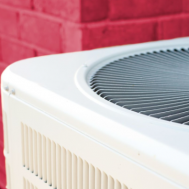The modern air conditioner was developed and patented all the way back (fittingly) in the heat of the summer of 1902. In addition to offering an escape from seasonal outdoor heat, inventor Willis Carrier’s creation paved the way for a number of aspects of the modern world that we may take for granted — the summer blockbuster (because who wants to sit in a movie theater that’s 90° F?), indoor shopping malls, international flights, and computer cooling systems. So, how do AC units work?
Rather than simply add cool air to your house, air conditioners actually remove the heat and humidity from the air inside your home altogether. But what’s the difference?
AC units work by taking in hot indoor air, cooling it, and returning it to your home environment while leaving the heat and humidity outside. There are two basic elements to this process, one which happens inside and another that happens outside.
1) Warm air inside the home cools down as it blows across a cold coil of refrigerant. The heat is absorbed by the refrigerant, turning the refrigerant from liquid to gas. This cooled air is returned to the house.
2) The refrigerant gas compresses into liquid, releasing the heat outside the home. The fan on the exterior part of the unit pulls outside air through the coil.
Keeping everything in place.
There are typically two concerns with rubber seals in AC applications; compatibility to the refrigerant and to the compressor oil. There are also two key parts of AC units that need to stay sealed in order to operate effectively; the evaporator coil and the connection point between the unit and the inside and outside of your home.
One of the primary components that makes an AC unit work is the refrigerant which is contained in an evaporator coil. That’s why evaporator coils are created as a closed circuit — it’s meant to prevent the dangerous chemicals in the refrigerant from leaking out.
The other important seal is the point where your AC unit meets your home. In window units, this point is your window sill. Once a window unit is secured, it’s important to create a proper seal around the unit to prevent warm, outside air, pests, or weather elements from entering your home through the gap. Maintaining a proper seal around your AC unit is also an easy way to keep your electricity bill down during the summer.
The cooling process explained.
Standard cooling systems use chemicals called “refrigerants” in concert with a compressor, a condenser coil, and an evaporator coil. These components quickly convert the refrigerant from gas to liquid and back.
The compressor increases the pressure and temperature of the refrigerant gas, sending it to the condenser coil and converting it to liquid. When the refrigerant then travels indoors and enters the evaporator coil, the liquid refrigerant evaporates and cools the indoor coil.
A fan blows warm, indoor air across the cool evaporator where the heat is absorbed by the refrigerant in the coil. Cool air circulates through the home while heated, evaporated gas goes to the outside compressor. The warm air from the interior is then released outside, allowing the refrigerant to return to its liquid state. This process repeats until your home reaches your desired temperature.
The result of all of this is a continuous cycle of heat and humidity being removed from the air inside your home, cool air returning to your home, and heat and humidity being removed — helping you stay cool all summer long!
Looking for more learning resources?
Check out the other blogs by Apple Rubber.
